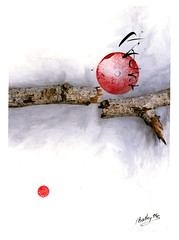Wednesday, May 23, 2007
Three Zen Stories
What do you think? I invite comments.
Man of Tao
A student once asked, "What is the difference between a Man of Tao and a little man?" The Zen Master replied, "It is simple. When the little man becomes a student, he can hardly wait to run home and shout at the top of his voice to tell everyone. Upon hearing the words of the master, he will climb to the rooftops and shout to the people. Upon learning the ways of the master, he will parade through town telling one and all about his new knowledge".
The Zen Master continues, "When the Man of Tao becomes a student, he will bow his head in gratitude. Upon hearing the words of the master, he will bow his head and his shoulders. Upon learning the ways of the master, he will bow to the waist and quietly walk alongside the wall so that people will not see him or notice him".
Enlightened
One day the Master announced that a young monk had reached an advanced state of enlightment. The news caused some stir. Some of the monks went to see the young monk. "We heard you are enlightened. Is that true?" they asked.
"It is," he replied.
"And how do you feel?"
"As miserable as ever," said the monk.
Sounds of Silence
Four monks decided to meditate silently without speaking for two weeks. By nightfall on the first day, the candle began to flicker and then went out. The first monk said, "Oh, no! The candle is out." The second monk said, "Aren't we not suppose to talk?" The third monk said, "Why must you two break the silence?" The fourth monk laughed and said, "Ha! I'm the only one who didn't speak."
Saturday, May 19, 2007
Taboos and Broken Hearts
I hadn’t read very far into Emptiness Dancing, the first book I ever read by Adyashanti, when I melted into tears and momentary collapse.
I had read this simple sentence:
The biggest barrier to awakening is the belief that it is something rare. When this barrier is dropped… then everything becomes instantly available to you. … it can’t be rare and difficult unless we insist it is.
I knew immediately that I carried the belief, and now apparently I was being given permission to let it go.
God, what a heart breaking relief – or Belief if I can truly let it in.
I am not alone in this.
How could anyone really feel deserving of the greatest spiritual blessing?
You can’t.
You couldn’t possibly deserve it.
So, there is this second belief too, “Oh, it’s not for me.”
This self-sabotage is subtly strengthened by the taboo, in many traditions, of speaking openly about one’s awakening. The Tao Te Ching makes it clear: "Those who know don’t say. Those who say don’t know."
Vedanta is no better. Maharishi was a monk, and monks don’t speak about themselves as “individuals.” So, we were taught to describe enlightenment while never ascribing any of the qualities as personal endowments. To behave otherwise was the height of crassness, vulgar, poor behavior and resulted quickly in open shunning by many of the organizational powers that be.
To this day, I struggle against a shame regarding speaking openly about my experiences.
How many times have I cringed as I compose this blog?
“I can’t say that!” But, sometimes I have.
I haven’t even understood entirely why.
I’ve just felt I needed to. Maybe in all this babble of saying and not knowing others may find a clue that helps them forward just a step.
So, it is with gratitude that I discovered this interview of Adyashanti.
It was originally published in the Fall, 2004 issue of Tricycle: The Buddhist Review. Stephan Bodian, the author, is a student of Adya’s.
The title of the interview is “The Taboo of Enlightenment.”
Bodian: In traditional Buddhism, at least as I practiced it, there’s a taboo against talking openly about enlightenment, as we’re doing now. It seems to be based on the fear that the ego will co-opt the experience and become inflated. In your dharma talks you speak in great detail about awakening, including your own, and in your public dialogues you encourage others to do the same. Why is that?
Adya: When I was sitting with my teacher, Arvis, we’d all go into the kitchen after the meditation and dharma talk and have some fruit and tea, and we’d talk openly about our lives. For the most part we didn’t focus on our spiritual experiences, but they were a part of the mix. Then these same people would do retreats at the Zen Center of Los Angeles and have big awakenings, and the folks in L.A. began to wonder what was happening in this little old lady’s living room up north.
Arvis’s view was simple: The only thing I’m doing that they’re not, she said, is that we sit around casually and talk, and what’s happening on the inside for people isn’t kept secret or hidden. This way, people get beyond the sense that they’re the only ones who are having this or that experience. They come out of their shell, which actually makes them more available to a deeper spiritual process.
The tradition of talking about certain experiences only in private with your teacher keeps enlightenment a secret activity reserved for special people. I can understand the drawbacks of being more open, of course. Some people may blab on about how enlightened they are, and become more egotistical. But when everything remains open to inquiry, then even the ego’s tendency to claim enlightenment for itself becomes obvious in the penetrating light of public discourse.
In the long run, both ways have their strengths and weaknesses, but I’ve found that having students ask their questions in public breaks down the isolation that many spiritual people feel - the sense that nobody else could possibly understand what they’re going through, or that they’re so rotten at their practice, or that nobody could be struggling like they are. And when people have breakthroughs and talk about them in public, awakening loses its mystique. Everyone else can see that it’s not just special people who have deep awakenings, it’s their neighbor or their best friend.
Bodian: Would you claim that you are enlightened?
Adya: Well, no, not with a straight face. I would say enlightenment is enlightened and awakeness is awake. It’s not an experience; it’s a fact.
--------------------------------------------------
So, I’m gonna keep on truckin’ here.
At the risk of sounding egotistical… or actually ignorant, seems more likely to me.
But, once again, “Oh, well.”
Monday, May 14, 2007
How Long is Now
This is my quick synopsis of how spiritual teachers address the Now.
My question is…
How big is the Now?
Or rather, How long is the Now?
On one hand you might say that it is infinite since an enlightened mind is fixed there and knows it to be all that Is. But, I’m thinking more down to earth.
I think it has to be physiologically constrained, because it takes a certain amount of time for electrical impulses to flow around the brain, and it takes a certain amount of time for chemicals to diffuse. There must be parameters for the Present set down by the body.
For instance, in Libet’s experiments the readiness potential preceded conscious awareness by about half a second. Is that how long the Now is? Is this the ball park we’re playing in - seconds as opposed to minutes or hours or days? Maybe.
Certainly the Now is not a point without dimension.
Most people would agree that a few hours from Now lies in “the future.” Even the desperate, “Wait a minute!” can put things off from Now.
Or is it that “in a minute” Now is usually completed?
Half a second to a minute, it’s all “ball park” to me at this point, psychologically and biologically.
On a subtler level, Professor Brian Josephson, a Nobel Prize-winning physicist from Cambridge University, says "It's not clear in physics why you can't see the future. In physics, you certainly cannot completely rule out this effect." …Virtually all the great scientific formulae which explain how the world works allow information to flow backwards and forwards through time.
So, now I have a corollary question, If we were to be able to receive information from the future – how far would we have to extend ordinary perception for it to become extra-sensory?
I can’t answer that.
I simply bring all this up by way of introduction to a new Blog I discovered today.
Dean Radin writes “Entangled Minds” and you might find a visit to his site stimulating.
Radin is a research psychologist associated with the Institute for Noetic Sciences. In skimming his blog I came across an article on precognition, which suggested to me that perhaps the Now might be on the order of three seconds.
Entangled Minds links to yet another site with an article about premonitions.
Radin hooked up volunteers to a modified lie detector, which measured an electrical current across the surface of the skin. This current changes when a person reacts to an event such as seeing an extremely violent picture or video. It's the electrical equivalent of a wince.
Radin showed disturbing or soothing images to volunteers in a randomly generated sequence. He soon discovered that people began reacting to the pictures before they saw them. They began to 'wince' a few seconds before they actually saw the image.
Hmmmm. It seems somewhat akin to Libet’s results, only this time it’s a totally different “experimental task.” The article had yet another link for me in the person of Kary Mullins.
In my lab we do a lot of something called PCR. The fellow who invented this technique for amplifying DNA, Kary Mullins, won a Nobel Prize for his efforts. Apparently, Mullins took an interest in Radin’s work and was himself tested. Here’s what Mullins had to say, "It's spooky. I could see about three seconds into the future. You shouldn't be able to do that."
So, check out Entangled Minds, or as a first pass check out this entry entitled “I Knew You Were Going to Read This.” It has a link to this article on “presentiment.” It also talks about how fewer people get on plans that ultimately crash than the statistical norm would suggest. For instance,
“The aircraft which flew into the Twin Towers on 9/11 were unusually empty. All the hijacked planes were carrying only half the usual number of passengers. Perhaps one unusually empty plane could be explained away, but all four?”
Apparently, people pick up enough info to somehow avoid these flights.
“You shouldn’t be able to do that.”
But apparently, we do.
The stuff on Entangled Minds should get you thinking. That’s good.
Just don’t let it pull you from the Now. ;) … right.
Thursday, May 10, 2007
The Source of Thoughts
That’s what Maharishi wanted us to say, back in 1971, as he instructed us on lecturing about meditation. It was his way of introducing what he called “The Source of Thought,” or the Absolute.
He said that people don’t know where thoughts come from, but they will agree that they come from somewhere… “somewhere deep inside.”
That was the first time I ever considered where my thoughts came from. I’d always simply assumed that thoughts just came out of my brain, the actual gray matter and electrical activity.
Maharishi got me to take a closer look. And it was then I realized that I had no idea where my thoughts came from; except perhaps as some knee-jerk reaction to outside events, though clearly, not every thing that crossed my mind was simply a reaction to the world.
Some thoughts seemed to come unbidden.
I simply seemed to “come up” with some thoughts.
Maharishi said that thoughts arose in the mind like a bubble from the depths of the ocean. They burst upon the surface of the ocean and the conscious thinking level. But there are all these antecedent levels, tiny, tiny bubbles and unconscious thoughts "deep inside."
All this came jumping into memory recently as I listened to Byron Katie on a CD of “Loving What Is.”
She had this to say about thoughts and where they come from:
One day I noticed I was not breathing.
Then to my amazement I noticed that I wasn’t thinking, that I was actually being thought, and that thinking wasn’t personal. You wouldn’t wake up in the morning and say to yourself, “I won’t think today.” It’s too late. You’re already thinking.
Thoughts just appear.
They come out of Nothing and they go back to Nothing like clouds moving across the empty sky.
They come to pass, not to stay.
There is no harm in them until we attach to them, as if they were true.
No one has ever been able to control his thinking, although people may tell you the story of how they have.
Thoughts are like the breeze, or the leaves of the trees, or raindrops falling.
They appear like that and through inquiry we can make friends with them.
Would you argue with a raindrop?
Raindrops aren’t personal and neither are thoughts. ….
How can you not think about something?
It’s thinking you.
Thought appears or it doesn’t.
It’s just amazing that you think (after how many years) that you can control your thinking.
Can you control the wind too?
What about the Ocean?
Let’s stop the waves.
[You can’t stop the waves.] Except when you’re asleep they stop.
No thoughts - no waves…
So it seems to me thoughts arise in our mind from somewhere deep inside, from something that controls Nature.
I think Katie would call that God.
She used the word Nothing.
That’s a Zen thing, Nothing. (I made the “N” a capital)
Maharishi called it the Absolute, or Everything.
By whatever name you give it, thoughts come from beyond the little, conscious self .
(I made that “s” the lower case.)
The Readiness Potential
Somewhere in time between Maharishi’s and Byron Katie’s comments, a scientist by the name of Benjamin Libet had enough experimental evidence to start a debate that rages to this day.
Libet asked his subjects to move a finger at some moment of their choosing. They were also to report when they made the decision to move by noticing the position of a dot circling a clock face. Meanwhile, an EEG monitored the electrical activity of their brains.
Earlier research had shown that consciously-chosen actions are preceded by a pattern of activity known as a Readiness Potential (or RP). RP’s indicate that the motor region of the brain was preparing to act upon a command like, “Move your finger.”
Strangely, Libet’s experiment showed that the time each person decided to move their hand consistently occurred after the RP appeared.
Thus, is seems as if the conscious decision to move a finger had been preceded by an unconscious command to which the brain began to react.
Other labs got similar results, and the debate has raged for decades.
Are our actions really generated subconsciously?
And what does this do to our notions of Free Will?
People were upset.
Daniel Wegner, a Harvard psychologist, calls it “The Mind’s Best Trick.”
We think of moving a finger and then do it, we think of going to the store for milk and do it, we think of looking away from this page – and then do it. It certainly doesn't take a rocket scientist to draw the obvious conclusion …[but] the mind has been known to play tricks… What if our minds keep … leading to an impression of conscious will again and again, but never revealing to us how our actions are actually caused?
To me, this is science stumbling upon, “Thoughts seem to come from somewhere deep inside.”
It seems, to me, to be the physiology supporting Adyashanti’s comments to those who look deep within their consciousness:
You might even start to notice that your thoughts, they are not even yours.
And how do you know that? Because when you…want your mind to stop, it doesn’t pay attention, does it.
… It’s my mind, or so the mind thinks, but at each moment …it’s an impersonal thing.
It thinks when it wants to think and stops when it wants to stop.
Student: “So you just let it?”
Adya: “Pretty much. Or you don’t, and you suffer like a dog.”
Ahhh, suffering!
Why bother about where thoughts come from?
Because if we don’t know, we make the mistake of thinking what that our thoughts are really REAL.
We make the mistake of confusing My Will for Thy Will.
Byron Katie emphasizes the non-reality of thoughts by calling them “stories.”
Spiritual Inquiry allows us to clearly see this. We are able to distinguish My Will and Thy Will. And this sets the stage for liberation, freedom from suffering, and Enlightenment.
Friday, May 04, 2007
Blue Squares and Asemic Calligraphy
We lay there & looked up at the night sky & she told me about stars called blue squares & red swirls & I told her I'd never heard of them. Of course not, she said, the really important stuff they never tell you. You have to imagine it on your own.
"Blue Squares," a Story of the Day, from StoryPeople.
And to me that’s what art is about. You have to imagine it. Or, let it flow from deep deep inside. Or let it take you deep inside.
I haven’t been here this past week because I have been working on my art. Making some and getting my other blog (Silence: a Gallery) organized into something of a real online gallery. In that process I have discovered some very interesting things (?), ideas … which I will share here.
First off I discovered the term “asemic calligraphy.”
Turns out this is what I have been doing in my art these past few years.
I never knew that.
I never knew what to call these doodles of calligraphy.
I do not know either kanji (Chinese characters) nor have I studied shodo (Japanese calligraphy). So of course my calligraphic-like swirls are without meaning, that is asemantic or "asemic."
This type of calligraphy is by definition without meaning. But meaning is missing only if we restrict ourselves to the surface and most superficial level of language. There are other possibilities. Or to quote the Australian artist Tom Venning:
“The letters are illegible, invented, or primal. The text has no verbal sense. Through its formatting and structure, it may suggest a type of document, or coded diagram, thereby, hint at meaning. Asemic writing can be understood through aesthetic intuition… through gut feeling.”
I executed the “writing” as an exercise in Taoist meditation, the guided movements I have mention before, only these were movements writ small... so small that it was simply almost writing rather than the grand flow of postures and mudras demonstrated during the practice of guided movements, or spontaneous Qigong.
I called my doodling “intuitive calligraphy.” I consider it both “guided” by the subtle flow of energy within me, as well as “spontaneous” as it simply is what flows out once the attention settles inward.
To me “intuitive calligraphy” is a meditative practice stemming from Taoism.
To me it ties into my understanding of sacred language, and memory, and transcending.
I think of it as the manual version of speaking in tongues.
Then suddenly, I discovered this term “asemic calligraphy.”
There is this whole other tradition focused around asemic calligraphy. (See asemic.net)
It is a tradition peopled with poets, artists, children scribbling.
Check this out for very different (yet related) way of viewing the intuitive calligraphic.
Turns out the roots can be traced to surrealism too.
Am I surprised? – no, delighted!






